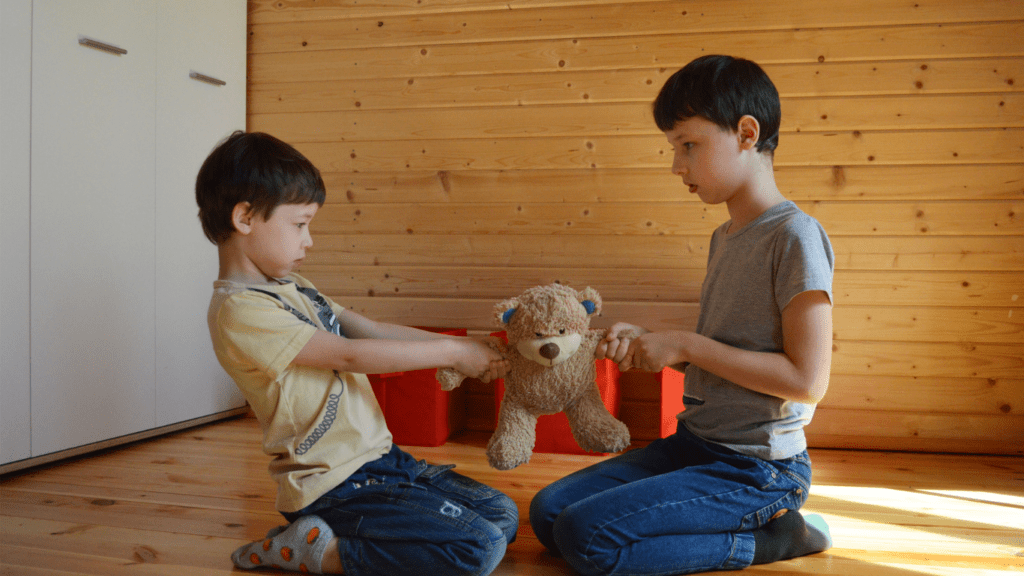Understanding Empathy
Empathy involves recognizing and validating others’ emotions. It’s essential for children because it helps them build genuine connections and navigate social situations. Empathy consists of three main components: cognitive empathy, emotional empathy, and compassionate empathy.
- Cognitive Empathy
Cognitive empathy refers to understanding another person’s perspective or mental state. For example, if a friend looks upset, a child exercising cognitive empathy might recognize that their friend might have had a bad day at school.
- Emotional Empathy
Emotional empathy involves feeling what another person is feeling. A child witnessing a peer getting hurt on the playground might feel a pang of discomfort themselves. This direct emotional response lies at the heart of emotional empathy.
- Compassionate Empathy
Compassionate empathy combines understanding and feeling with action. When a child not only realizes and shares a peer’s distress but also offers help, they’re practicing compassionate empathy. For instance, comforting a sad friend with kind words or a hug exemplifies compassionate empathy.
Understanding these components provides a foundational grasp of empathy, enabling parents to teach it more effectively.
Importance of Teaching Empathy
Teaching empathy transforms children’s ability to connect with others and enhances their emotional intelligence.
Benefits for Children
Empathetic children excel in social settings. They navigate friendships, family interactions, and school environments more effectively because they understand other perspectives. Studies show higher empathy levels correlate with improved academic performance and emotional resilience. Children who practice empathy demonstrate reduced aggression, enhanced self-esteem, and increased cooperation.
Benefits for Society
Empathy fosters a compassionate society. When children learn to empathize, they’re more likely to become supportive adults who contribute positively to their communities. Empathetic individuals reduce social conflicts and promote inclusivity. For instance, a workplace with empathetic employees reports higher job satisfaction and productivity. Empathy also drives charitable behaviors, increasing volunteering and social support.
Effective Strategies for Teaching Empathy

Engaging in specific, purposeful activities is essential to teach empathy. Kids learn best through direct experience and guided practice.
Role-Playing Activities
Role-playing activities encourage kids to step into someone else’s shoes. I use scenarios where children play different roles, such as a friend feeling sad or a newcomer at school. These exercises help kids practice responding to various emotions. Children learn to:
- understand different perspectives
- gaining cognitive empathy
For example, if a child acts as a person who lost a favorite toy, they start understanding the associated feelings.
Reading and Discussing Stories
Reading stories with empathetic characters can be very effective. I choose books where protagonists face emotional challenges and encourage children to discuss these emotions. Questions like, “How do you think the character feels?” promote emotional empathy. Discussing scenarios from the stories leads to deeper understanding and personal connections. Books like “Wonder” by R.J. Palacio and “Charlotte’s Web” by E.B. White offer rich opportunities for empathy discussions.
Encouraging Emotional Expression
Encouraging children to express their emotions openly is vital. I create a safe space where kids feel comfortable sharing their feelings. Properly labeling emotions helps in emotional empathy development. Activities like “Emotion Charades”, where children act out different emotions, can be highly beneficial. Such practices teach kids to recognize and articulate their own and others’ feelings, fostering compassionate empathy.
These strategies, integrated thoughtfully, lay a strong foundation for raising empathetic children.
Role of Parents and Educators
Parents and educators play a critical role in teaching empathy to children. Their influence shapes how children perceive and interact with the world.
Parents as Role Models
Children often learn empathy by observing their parents’ behavior. When I express understanding and concern for others’ feelings, my child absorbs these actions and mirrors them. For example, if I comfort a friend or show kindness to someone in need, my child learns these empathetic behaviors. Studies from Harvard University show that children who grow up in empathetic households are more likely to become empathetic adults. Consistently demonstrating empathy at home creates a nurturing environment that encourages children to adopt similar behaviors.
Educators’ Influence in Schools
Educators can promote empathy in a structured setting. My child’s teacher uses activities like group projects and open discussions to foster a collaborative and understanding atmosphere. These activities help children practice empathy by considering classmates’ perspectives. Research from the Yale Center for Emotional Intelligence indicates that schools implementing social-emotional learning (SEL) programs see improved student empathy and reduced bullying rates. By incorporating empathy-focused activities into the curriculum, educators can significantly impact a child’s ability to understand and relate to others, reinforcing the empathetic lessons taught at home.
Challenges and Solutions
Empathy development in children can encounter several challenges. By identifying these challenges and applying targeted solutions, we can foster a more empathetic future generation.
Overcoming Empathy Fatigue
Children can experience empathy fatigue when they are repeatedly exposed to others’ suffering, leading to emotional exhaustion. To address this, I ensure children understand the importance of setting emotional boundaries. Teaching self-care routines, like engaging in hobbies and spending time with friends, helps prevent burnout. It’s also crucial to offer support and create an open environment where children can express their feelings. Studies show that balanced exposure and support can mitigate empathy fatigue while maintaining empathy levels.
Addressing Cultural Differences
Cultural differences can pose a challenge in teaching empathy, as children may not easily relate to those from diverse backgrounds. To bridge this gap, I introduce children to various cultures through books, films, and activities that celebrate diversity. Providing opportunities for them to interact with peers from different backgrounds fosters understanding and acceptance. Programs promoting global awareness enhance cognitive empathy, helping children appreciate diverse perspectives and experiences. Research suggests that culturally diverse educational environments enhance empathy and reduce prejudice among children.



 Jameslee Silverayees – Founder Jameslee Silverayees is the founder and driving force behind Makes Parenting Watch, a comprehensive platform designed to support parents at every stage of their journey. As a parent himself, Jameslee recognized the overwhelming amount of information available and the need for a trusted source that offers practical, expert-backed advice. Drawing on his own experiences and his passion for family well-being, he created Makes Parenting Watch to be a one-stop resource for news, updates, and tips on everything from newborn care to family travel. Under his leadership, the website has grown into a highly respected community of parents, caregivers, and experts who come together to share insights and solutions. Jameslee is deeply committed to empowering families with the knowledge they need to raise healthy, happy children while fostering stronger family bonds.
Jameslee Silverayees – Founder Jameslee Silverayees is the founder and driving force behind Makes Parenting Watch, a comprehensive platform designed to support parents at every stage of their journey. As a parent himself, Jameslee recognized the overwhelming amount of information available and the need for a trusted source that offers practical, expert-backed advice. Drawing on his own experiences and his passion for family well-being, he created Makes Parenting Watch to be a one-stop resource for news, updates, and tips on everything from newborn care to family travel. Under his leadership, the website has grown into a highly respected community of parents, caregivers, and experts who come together to share insights and solutions. Jameslee is deeply committed to empowering families with the knowledge they need to raise healthy, happy children while fostering stronger family bonds.
